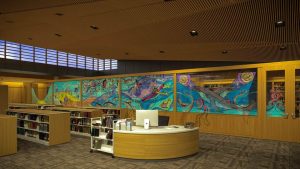“You just experienced project-based learning.
What did the teacher in you learn?”
The teacher in me learned that project-based learning can be both frustrating and brilliant. The student in me was reminded how challenging it can be to be patient. The teacher in me was reminded about the importance of scaffolding.
Use of technology: In this course, I gained new tech tools and ideas on how to build technology into the classroom and curriculum. Understanding technology is a current “gate-keeper,” so I appreciate us being pushed to both learn it and teach it to one another. I think it is critical to use technology in the classroom to connect with students in a digital era, but also to help them succeed in it.
The iBooks project helped me gain insight into what it will be like to teach at a constructivist charter school. As a group member, I had to step back and recognize that everyone works differently and at their own pace. I will have to do the same as a teacher, so this was an important lesson.
In my own classroom, I will have more time to help students learn about the technology they are using before we begin a project. If I were to do an iBook project with my class, I would have them work in pairs and I would let students start out with a narrow, specific topic of their choice (within a given theme). I would give them a sort-of “starter” project before jumping into a more complex research project or book. Students will need to have a common understanding of what iBooks can do and how to effectively write for a digital publication. During my student teaching I will be teaching the same groups of students language arts and social studies, so it’s important for me to be thinking about interdisciplinary teaching. I would do a unit on how to write for digital publications and how to conduct online research in language arts, simultaneously with a social studies unit on any given historical topic.
 A quick note on place-based learning & using our community resources wisely… It was so exciting to get to spend time in the new museum and archives! This gave a real authenticity to what we were learning about, especially for those of us who couldn’t visit our region. I will absolutely use this space since I’ll be teaching within walking distance of the SLAM building.
A quick note on place-based learning & using our community resources wisely… It was so exciting to get to spend time in the new museum and archives! This gave a real authenticity to what we were learning about, especially for those of us who couldn’t visit our region. I will absolutely use this space since I’ll be teaching within walking distance of the SLAM building.
Alaska Studies: For my own chapters, I learned a lot about my individual region and learned a little more about commonalities and differences between regions. Through reading other groups’ work, I gained a bit more information about other regions, but not as much about Alaska as a whole. At times, the learning seemed fragmented. Even within my own region, I focused so much on my own sections, that I did not get to really dive deep into others. This is a challenge with project-based learning, it takes time and students miss details when they are focused on their own interests. I appreciated that the course was taught in combination with Angie’s course so we could continue to gain a deeper, cohesive understanding of multi-cultural ed. while working on the iBook. I think before teaching Alaska Studies to my students, I have a lot more learning to do on the big picture, historical timelines, and cultures in each region… but now I’ll have the tools I need to gain a broader and deeper understanding, including an iBook to use in my classroom!
I am so glad you brought up use of technology. Even though it was central to everything we learned in our Alaska Studies class, I forgot to mention it in my reflection. I loved how we got to learn the technology for ourselves through a totally hands on approach, that way we will not forget how to use it. Just as you mentioned, I would love to use iBooks in my classroom next year.